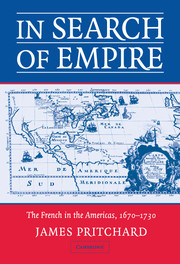Book contents
- Frontmatter
- Contents
- List of Illustrations
- List of Maps and Graphs
- List of Tables
- Preface
- Dates, Weights, Measures, and Currency
- List of Abbreviations
- Part I Colonies Formed
- Part 2 Colonies Defended
- 6 The Franco-Dutch War, 1672–1678
- 7 The Nine Years' War in America, 1688–1697
- 8 The War of the Spanish Succession in America, 1702–1713
- 9 Elusive Empire
- Appendixes
- Bibliography
- Index
8 - The War of the Spanish Succession in America, 1702–1713
Published online by Cambridge University Press: 05 June 2012
- Frontmatter
- Contents
- List of Illustrations
- List of Maps and Graphs
- List of Tables
- Preface
- Dates, Weights, Measures, and Currency
- List of Abbreviations
- Part I Colonies Formed
- Part 2 Colonies Defended
- 6 The Franco-Dutch War, 1672–1678
- 7 The Nine Years' War in America, 1688–1697
- 8 The War of the Spanish Succession in America, 1702–1713
- 9 Elusive Empire
- Appendixes
- Bibliography
- Index
Summary
INTRODUCTION
Louis XIV's acceptance of the succession to the Spanish throne on behalf of his grandson, Philippe d'Anjou, late in 1700 might have received assent from other European states but for three subsequent actions. They were the king's sudden occupation of the southern Netherlands on his grandson's behalf; his securing privileged access to Spanish America for French merchants by acquiring the asiento or royal monopoly to sell African slaves in Spanish America; and finally, Louis XIV's recognition of James II's son as the King of England, thereby violating the terms of the Treaty of Ryswick. The War of the Spanish Succession was about whether or not France would gain hegemony in Europe, but more than ever before it was also about colonies and trade in America. The last Spanish Hapsburg died on 1 November 1700, and the French king's grandson ascended the Spanish throne as Philip V. In September of 1701, England, the United Provinces, and the Emperor renewed the Grand Alliance and sought to impose their collective will on both Spain and France. During the next 11 years, well-trained, well-led armies engaged in some of the bloodiest campaigns in European history prior to the twentieth century. Though allied might could deeply wound, it could not destroy Louis XIV's France. Changing political circumstances in England in 1710 and Austria in 1711 could no longer keep the Allies together, and under the impetus of mutual betrayal, peace occurred in 1713.
- Type
- Chapter
- Information
- In Search of EmpireThe French in the Americas, 1670–1730, pp. 358 - 401Publisher: Cambridge University PressPrint publication year: 2004



